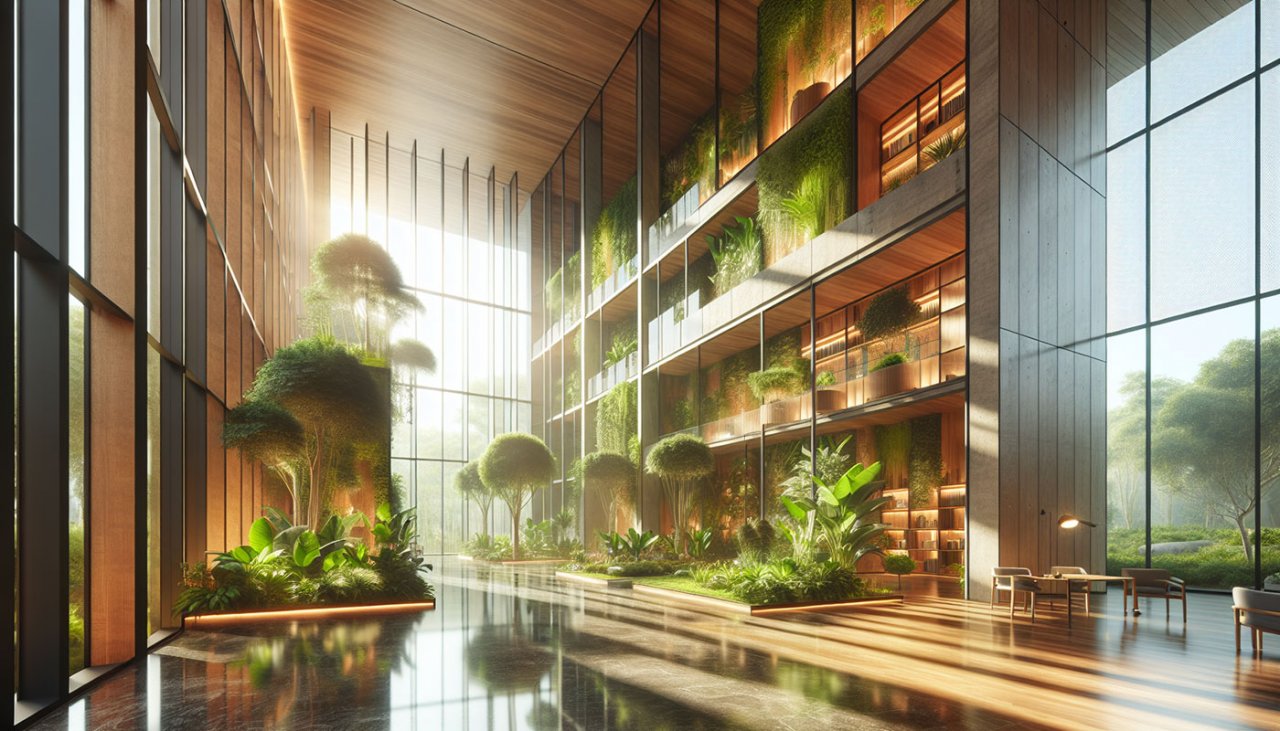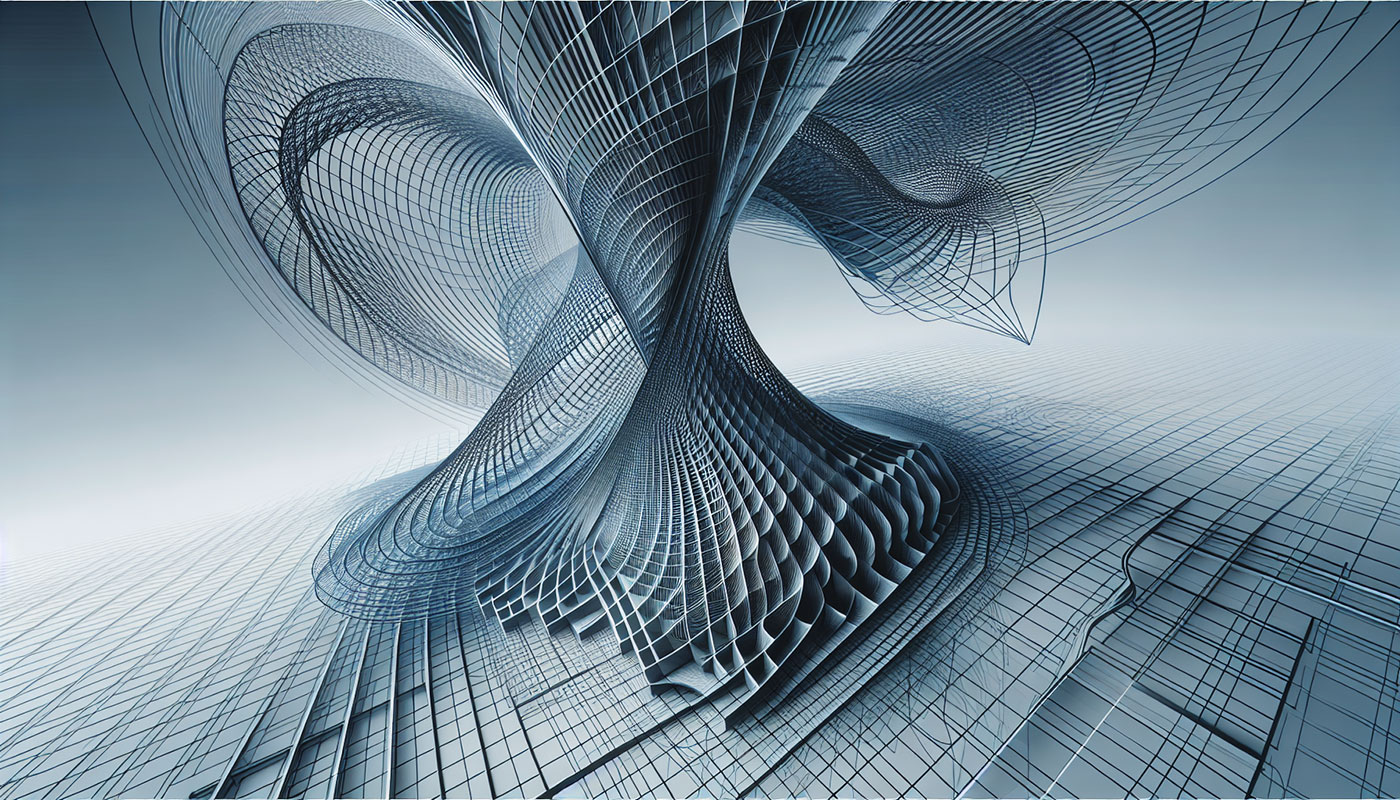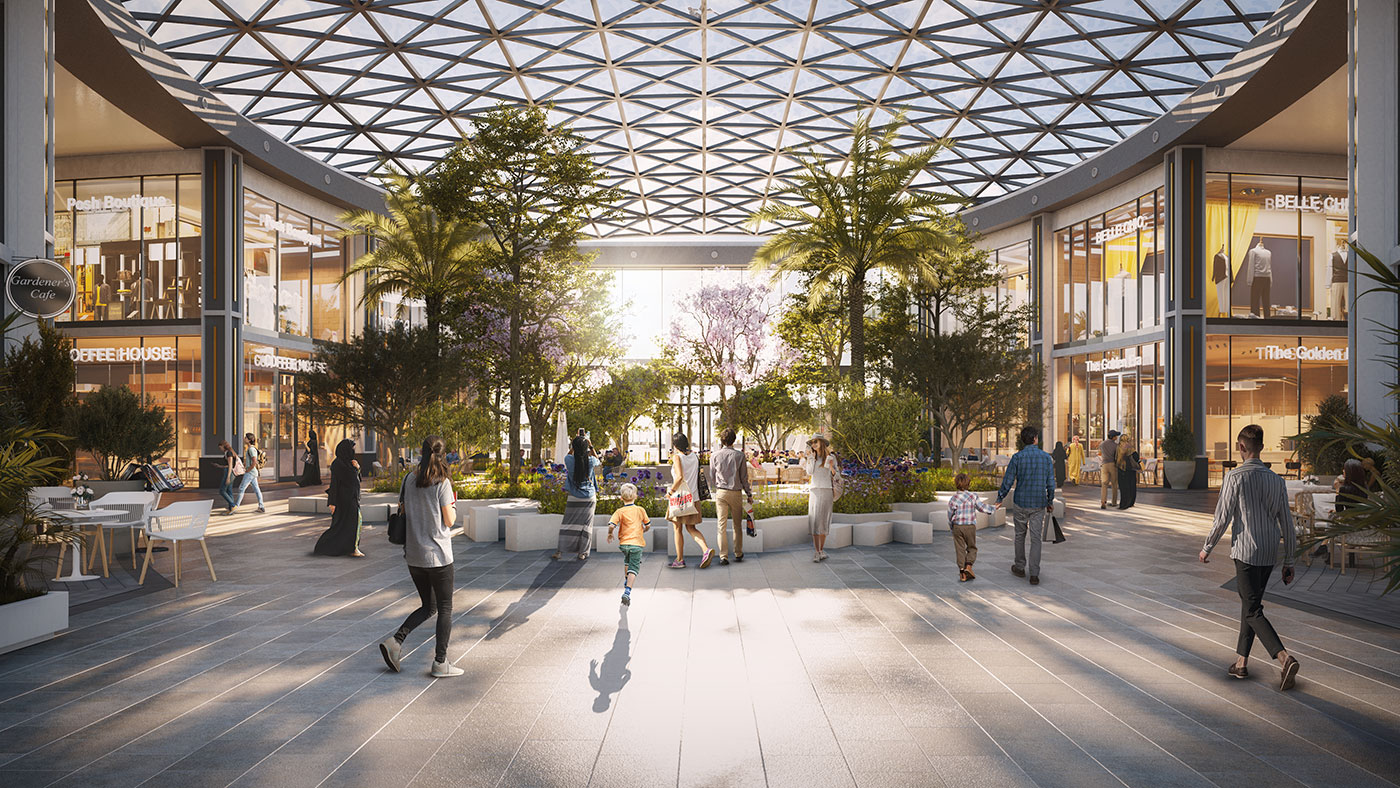Discover the Latest Architectural Visualization Trends Shaping 2024

Arqsix
January 29th, 2024

In search of the latest architectural visualization trends reshaping the industry in 2024? From the integration of cutting-edge technologies such as AI and VR to the conscious selection of sustainable materials, this guide spotlights the trends that are defining the future of architectural design. Learn about the tools and practices empowering architects and designers to create more interactive, efficient, and eco-friendly visualizations.
Embracing Biophilic Design and Sustainability
 Generated by SurferAI
Generated by SurferAI
In the world of architectural visualization, the significant role of biophilic design cannot be ignored. As a concept, it focuses on fostering a connection between people and nature through the creation of buildings and spaces. Tangible instances of biophilic design in architectural visualization encompass the utilization of rammed earth structures, recycled materials and furnishings, and strategic consideration of the site’s sun orientation. Have you ever noticed the integration of houseplants and hanging plants in interior spaces in architectural renderings? That’s biophilic design at its best.
Sustainability plays a key role in biophilic design for architecture, especially seen in the use of green roofs and living walls. These elements not only reconnect occupants with nature but also contribute to energy efficiency, an essential factor in today’s energy-conscious world. The advantages of integrating biophilic design and sustainability in architectural visualizations are manifold. From enhanced well-being to decreased energy usage and waste generation, these design ideas are indeed shaping the future of architecture.
You might be curious about the types of materials that are environmentally sustainable in architecture. Well, architects are increasingly opting for:
Cob
Recycled steel
Bendable concrete
Mass timber
Stone
Bamboo
Cork
Adobe brick
Straw bale
Cordwood
These materials are a part of the architectural rendering trends that focus on sustainability.
However, if you want to learn more about sustainable design practices, read our article about the biophilic design process.
The Rise of Real-Time Rendering
Real-time rendering in architectural visualization is:
The process of instantly generating 3D images and animations
Facilitating interactive and immersive experiences
Empowering architects and designers to visualize their designs in real-time
Streamlining decision-making and idea communication
In the field of architectural visualization, emerging trends are revolutionizing the intricate processes involved.
By enhancing speed, efficiency, and collaboration opportunities for architects, real-time rendering is reshaping the architectural visualization process. This emerging trend has taken the architectural rendering industry by storm. But what makes real-time rendering possible? Technologies such as GPU ray-tracing, rasterization, and real-time 3D rendering software like D5 Render and Enscape are the driving forces behind this innovation.
One of the key benefits of real-time rendering is:
The provision of immediate visual feedback in architectural design
It allows clients to explore the design from various perspectives and inquire about specific details during design review meetings or presentations
This enhances client engagement and expedites the design process.
AI-Driven Architectural Visualization
AI-driven architectural visualization also figures among the key trends for 2024. This involves the utilization of artificial intelligence technology to generate immersive and interactive environments, enabling users to navigate and explore architectural designs.
But how does AI contribute to enhancing the quality of architectural visuals? By generating:
aesthetically coherent furniture
décor
artwork
literature for indoor spaces
AI expedites the production of photorealistic images and animations, resulting in improved accuracy and realism.
Beyond its aesthetic benefits, AI-driven architectural visualization offers the following advantages:
Simulating natural lighting, airflow, and energy consumption to enhance the environmental performance of a building prior to construction
Optimizing designs for sustainability
Utilizing cloud-based rendering solutions for further optimization
The benefits of AI in architectural rendering include:
Automating time-consuming and repetitive tasks, such as generating floor plans and optimizing space
Reducing manual labor
Decreasing the time and effort needed to create renderings and immersive experiences
However, it's worth mentioning that the design process is very different when it comes to AI. It might be one of the most significant architectural visualization trends, but 3D artists will still play a crucial role in the design process.
VR and AR: Transforming Architectural Spaces
 Generated by SurferAI
Generated by SurferAI
Virtual Reality (VR) and Augmented Reality (AR) technologies are showcasing their transformative potential in architectural visualization. These technologies are not just enhancing designs and fostering creativity, but they are also providing architects, designers, and clients with immersive experiences in virtual environments, thereby giving life to conceptual designs.
Virtual reality and augmented reality technologies are at the forefront of architectural visualization, providing immersive experiences and dynamic interactions with architectural designs.
Cloud-Based Platforms: Powering Collaboration and Accessibility
Collaboration in architectural visualization is being revolutionized by cloud-based platforms. They facilitate real-time communication and collaboration among team members, regardless of their physical location, supporting various aspects of architectural projects and promoting seamless communication among team members.
What makes a cloud-based platform particularly suitable for architectural visualization? Key features include:
Modeling
Analysis
Visualization tools
VR/AR integration
AI-powered rendering
Enhanced realism with ray tracing
Cloud-based rendering services
Real-time rendering
These features are shaping the architectural rendering industry by providing advanced rendering tools. These can create anything from lighting effects, technical drawings to actual photorealistic rendering.
The process of cloud rendering involves:
Utilization of render farms and cloud technology
Expedited production of 3D animations and images
Leveraging specialized computing systems in the cloud
Enhancing accessibility by optimizing resource utilization
Facilitating increased flexibility and scalability
Promoting collaborative resource sharing.
The primary cloud-based platforms utilized in architectural visualization are SketchUp, D5 Render, Revit, Archicad, Enscape 3D, Foyr Neo, V-Ray, Cinema 4D, Autodesk Revit, and Houdini.
Parametric Design and Computational Modeling
 Generated by SurferAI
Generated by SurferAI
The integration of parametric design and computational modeling is another trend influencing the future of architectural visualization. Parametric design in architecture is a method based on algorithms that integrates design intent with the design outcome, enabling the creation of intricate and pioneering architectural forms.
Parametric design and computational modeling incorporate advanced algorithms into the visualization process by utilizing computational algorithms and parametric modeling techniques to generate, validate, and enhance architectural designs. This method streamlines modeling procedures and facilitates the exploration of new design possibilities.
The benefits of utilizing parametric design and computational modeling in architecture are manifold. From the capacity to modify design parameters to produce numerous design variations, to adaptability in design and expedited processes, these techniques bring about significant cost savings. Several architectural projects that have employed parametric design and computational modeling are the Walt Disney Concert Hall, BEEAH Headquarters, Museo Soumaya, Atyrau Bridge, and JetBrains Office.
Enhancing Engagement with Immersive Storytelling
 Generated by SurferAI
Generated by SurferAI
Another trend boosting engagement in architectural visualization is immersive storytelling. By creating a compelling narrative that animates architectural ideas, it effectively communicates intricate design concepts, technical details, and the human experience. This method enriches client engagement by promoting comprehension, establishing an immersive narrative environment, and eliciting emotions through captivating visual storytelling.
A variety of methods are employed in immersive storytelling for architectural visualization. These include:
Videography
Realistic and stylized visualizations
Creative/futuristic visuals
Cutaway renderings
Dynamic visualizations
Installations
Intuitive navigation
Immersion via interactions
Animation
These methods are used to create compelling visual experiences.
Interactive 3D tours significantly elevate immersive storytelling by enabling viewers to dynamically navigate architectural spaces at their own speed. By offering the option to zoom in for specific details or zoom out for a broader perspective, interactive 3D tours not only enhance client engagement but also support the pre-selling of properties and foster a stronger attachment to the design.
Inclusivity and Universal Design in Architectural Visualization
 Generated by Arqsix
Generated by Arqsix
Reflecting a rising awareness of their importance in design practices, architectural visualization is placing growing emphasis on inclusivity and universal design. Inclusivity in architectural visualization refers to the incorporation of diversity in the people within the visualization, showcasing a variety of ages, ethnicities, and abilities, and creating designs that can accommodate different communities seamlessly. Universal design principles in architectural visualization have a significant impact on inclusivity by accommodating a variety of abilities, ensuring usability for everyone, and creating visual representations that are accessible and inclusive.
The guiding principles for creating universal design in architectural visualization encompass equitable use, flexibility in use, simple and intuitive use, perceptible information, tolerance for error, and low physical effort. Architectural visualization contributes to accessibility for individuals with disabilities by incorporating features such as Braille signage for individuals with visual impairments, ensuring easy navigation and utilization of buildings and public spaces, and using 3D modeling to overcome accessibility challenges and design inclusive buildings.
As Arqsix, we've seen the need for this diversity as well. There's been a significant increase over the past year, with 35% more of our clients requesting a diverse representation of people within the virtual spaces we create for them.
Navigating Ethical Considerations in Architectural Visualization
The significance of addressing ethical considerations in architectural visualization cannot be emphasized enough. Privacy in architectural visualization encompasses safeguarding the confidentiality of architectural projects through methods such as non-disclosure agreements (NDAs) in CG visualization studios and anonymizing data prior to visualization creation, eliminating or concealing any identifying information.
However, with the rise of AI-generated content in architectural visualization, there are new challenges to navigate. The misuse of AI-generated content can manifest in various forms, such as copyright infringement, violations of intellectual property, and ethical considerations related to the ownership and utilization of the generated renderings.
Architects and visualization professionals are advised to consider the following strategies:
Acknowledge and mitigate potential harm in visualizations
Adapt workflows to incorporate new technologies
Maintain honesty and integrity in dealings
Evaluate the ethical implications of AI-driven design
Key Takeaways
Architectural visualization in 2024 places a strong emphasis on biophilic design and sustainability, integrating natural elements and sustainable materials into designs to improve well-being and environmental performance.
Real-time rendering and AI-driven technologies are at the forefront, offering immediate visual feedback, enhancing collaboration, and streamlining the design process with automated optimizations and immersive experiences.
Emerging trends also include the use of VR/AR for transformative experiences, cloud-based platforms for collaboration and accessibility, advanced parametric design, and a focus on inclusivity and ethical considerations in architectural visualization.
Summary
From embracing biophilic design and sustainability, the rise of real-time rendering, AI-driven architectural visualization, the transformative potential of VR and AR technologies, to the power of cloud-based platforms and the integration of parametric design and computational modeling, the architectural visualization trends of 2024 are set to revolutionize the industry. With an emphasis on inclusivity, universal design, and ethical considerations, these trends are not just shaping the future of architecture, but also influencing the way we live, work, and interact with the built environment. Let’s embrace these trends and shape a sustainable, inclusive, and ethically responsible future.
FAQs
Our location
Ready to share your expertise?
We welcome submissions from talented writers and experts in various fields who are passionate about sharing their knowledge and insights with our audience.
Write for UsArqsix - Shaping Stories, Shaping Spaces
Elevating real estate marketing for a world that’s always evolving.
2025 © Arqsix. All Rights reserved. |Sitemap|Privacy Notice